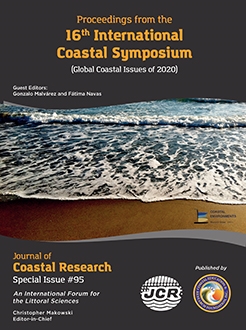Kudryavtseva, N.; Räämet, A., and Soomere, T., 2020. Coastal flooding: Joint probability of extreme water levels and waves along the Baltic Sea coast. In: Malvárez, G. and Navas, F. (eds.), Global Coastal Issues of 2020. Journal of Coastal Research, Special Issue No. 95, pp. 1146–1151. Coconut Creek (Florida), ISSN 0749-0208.
An accurate assessment of the joint probability of water levels and waves is crucial to establish appropriate mitigation and adaptation strategies for possible flooding and coastal erosion in countries with extensive low-lying nearshore areas. The simultaneous occurrence of large waves and high still water levels can significantly increase the risk of flooding and damage of coastal constructions. In this study, the water level extremes were retrieved from simulated high-resolution 3D NEMO-Nordic water level data along the Baltic Sea coast with a spatial resolution of 2 nautical miles (∼3.7 km) and time resolution of 1 hour. The wave height data were obtained from the numerical simulations using the WAM wave model with adjusted geostrophic wind forcing with 3 nautical miles spatial resolution and the time resolution of 1 hour. Using the Archimedean copula approach, the likelihood of joint occurrence of high water levels and wave heights was evaluated along the whole Baltic Sea coast for 1979–2007. Four distinctive regions in the Baltic Sea were identified following differences in the dependence between the sea level and wave height extremes in terms of their correlation. The Arkona basin and eastern part of the Baltic proper have low dependence (correlation coefficient <0.2), the Gulf of Riga, the Gulf of Finland and north-western part of the Baltic Proper exhibit moderate dependence (0.2–0.5), the Sea of Bothnia has the strongest dependence (0.5–0.7), and the Bay of Bothnia has a dependence in the range of 0.2–0.4, similar to the central Baltic Sea region. The joint probability analysis showed that the highest risk of simultaneous appearance of water level and wave height extremes is observed in the Sea of Bothnia. The study demonstrates that it is crucial to consider the combination of both water levels and wave heights in all regions of the Baltic Sea except for the southern areas.





